International Conference on: Crimes Against Humanity in 21st Century
The role of International Organisations
Irish College Leuven, 24–25 November 2023

Opening Remarks – Crimes Against Humanity in the 21st Century: The Role of International Organizations
Hüseyin Demir, Research Group on Human Rights and Politics
Prof. Hüseyin Demir opened the conference by underscoring the urgency of addressing crimes against humanity in our era of global connectivity and human rights awareness. While acknowledging progress in international law and communication, Demir highlighted the ongoing perpetration of grave human rights violations across the globe. He emphasized the role of international organizations as crucial actors in both preventing atrocities and ensuring justice. The conference serves as a platform for collective dialogue, expert exchange, and the formation of a research and activist network dedicated to human rights.
Gallery
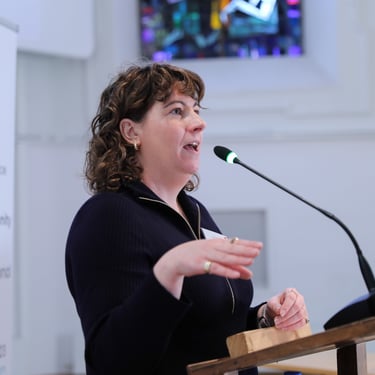
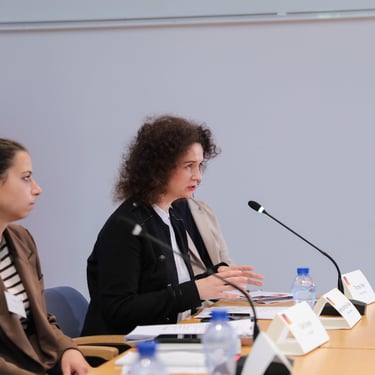
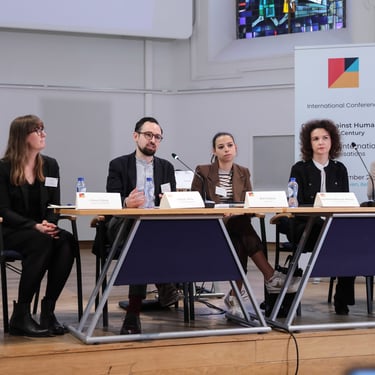
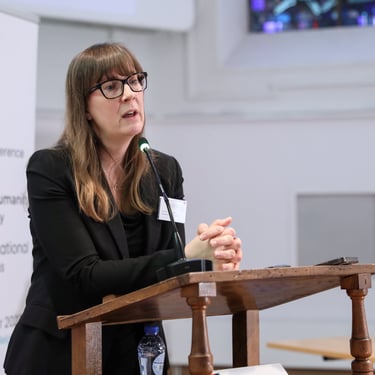
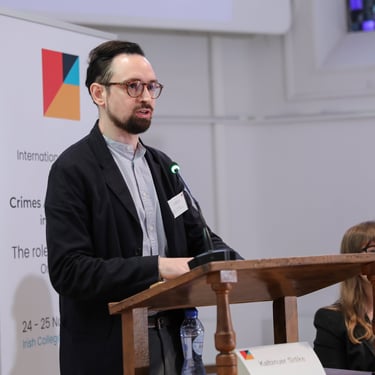
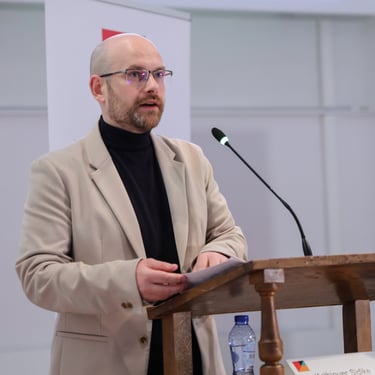
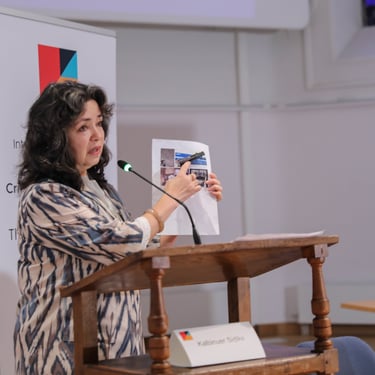
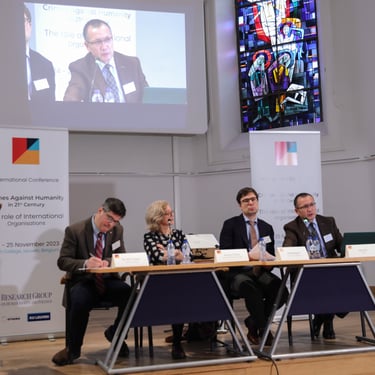
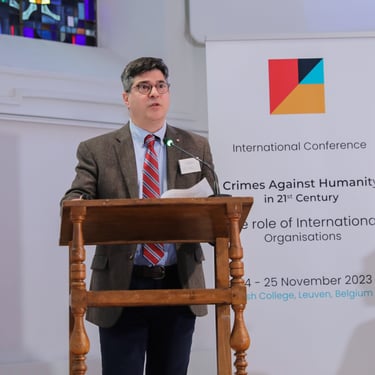
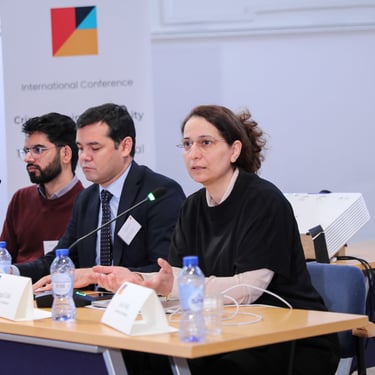
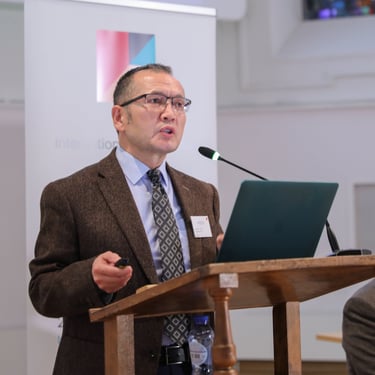
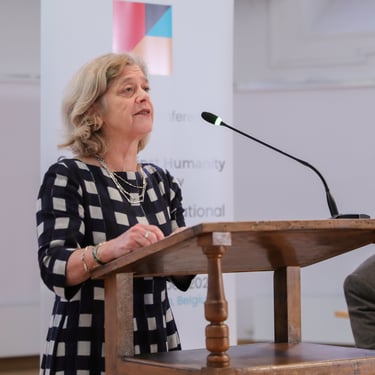
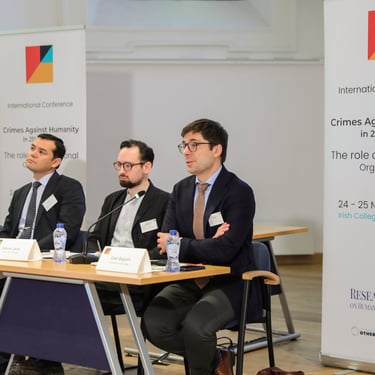
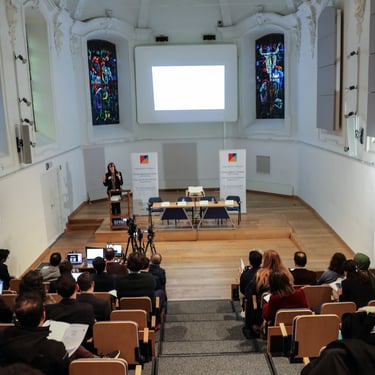
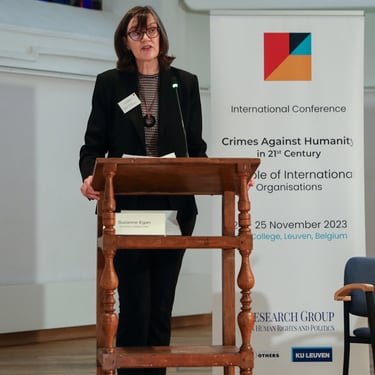
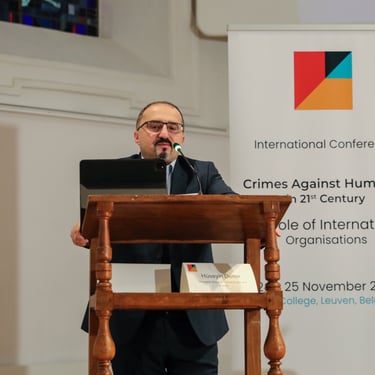
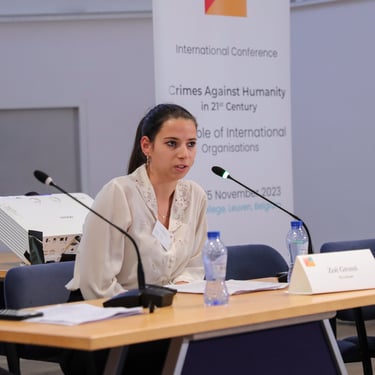


Barriers to Implementing the Responsibility to Protect Effectively: Searching for Accountability Closer to Home
Chloë Gilgan, Lincoln Law School, University of Lincoln
Dr. Chloë Gilgan examines why the Responsibility to Protect (R2P) framework is often inadequately implemented by Western states, focusing specifically on the UK’s role during the Syrian refugee crisis. She challenges the assumption that Western liberal states naturally internalize human rights norms and explores how R2P is localized—or misunderstood—within UK domestic institutions.
Key findings of her empirical research (interviews, policy analysis) include:
UK officials often associate R2P solely with military intervention, sidelining its broader peaceful measures.
Refugee protection efforts (e.g., resettlement schemes) were not framed as part of R2P responsibilities.
This disconnection leads to policy fragmentation and undermines the norm of protection.
Civil society organizations, in response, had to rebrand or reframe R2P (e.g., as "protection of civilians") to engage the government effectively.
Gilgan highlights that norm resistance, especially post-Libya, has resulted in a political reluctance to reference R2P—even when non-military actions like humanitarian aid or refugee resettlement are involved.

Rethinking the Institutional Barriers to Mass Atrocity Prevention: The Future of the Responsibility to Protect (R2P) in the UN System
Samuel Jarvis, York St John University
Dr. Jarvis critically examined the failures and future potential of the Responsibility to Protect (R2P), emphasizing that while the principles of atrocity prevention remain vital, the institutional frameworks—particularly the UN Security Council—have proven largely ineffective.
R2P is not dead, but deeply constrained. Despite cynicism, calls for international response to atrocities persist.
The UN Security Council has been unable to deliver on R2P due to political division, selective implementation, and abuse of the norm—especially after the 2011 Libya intervention, which many saw as regime change under the guise of civilian protection.
This episode caused loss of credibility and accusations of Western hypocrisy, shifting R2P discourse from military intervention (Pillar III) to prevention and capacity-building (Pillars I & II).
Institutional barriers:
The Security Council is no longer seen as a viable forum for leading atrocity prevention, and reform efforts are unlikely to succeed.
The UN General Assembly, Human Rights Council, and Arria-formula meetings can offer platforms for discourse—but lack enforcement power.
Karen Smith, former UN Special Adviser on R2P, noted that atrocity prevention is often sidelined within the UN due to competing agendas and fear of jeopardizing diplomatic relations.
Beyond the UN:
Regional organizations (e.g., African Union, ASEAN) can offer proximity-based support and early warning, but remain limited by sovereignty norms and non-intervention principles.
Civil society and individual states must increasingly take on the burden of implementation, especially in the absence of Security Council leadership.

The Crimes Against Humanity and the Ukraine War
Gleb Bogush, University of Copenhagen
Dr. Gleb Bogush urged the international community to recognize the scale and systemic nature of these crimes and to reform mechanisms for justice and prevention.
Despite extensive civilian suffering, discussions around crimes against humanity in the Ukraine war are overshadowed by focus on war crimes and aggression.
The UN Independent International Commission of Inquiry on Ukraine is the first authoritative body to systematically analyze and label some acts as potential crimes against humanity.
Bogush cited multiple patterns of systemic abuse by Russian forces:
Widespread torture of civilians and prisoners of war, especially in occupied regions (e.g., Kherson, Donetsk), deliberate attacks on civilian infrastructure (e.g., electricity, water) interpreted as tools of terror and suppression, conflict-related sexual violence against civilians, Mass deportation of Ukrainian children, potentially constituting both war crimes and crimes against humanity.
Bogush highlighted the interconnection between aggression and crimes against humanity, suggesting the latter can be both consequence and expression of the former.
According to Bogus, there’s a legal and cultural gap in addressing crimes against humanity in the region:
Ukraine, Russia, and Belarus lack domestic legal provisions on crimes against humanity.
Even in international efforts (e.g., ICC, national jurisdictions), results are slow and limited.
Impunity is a root cause of repeated violations.
Previous atrocities (e.g., Chechnya, Crimea) were ignored or inadequately addressed, encouraging further violence.
Russia’s internal repression, state propaganda, and external hybrid operations created fertile ground for current atrocities.
·

The United Nations Human Rights Council Special Sessions and Fact-Finding Missions: Shining a Spotlight on Abuses or Failing to Protect?
Rosa Freedman, University of Reading
Prof. Rosa Freedman critically examined how the UN Human Rights Council (HRC) responds to mass atrocities and potential crimes against humanity through fact-finding missions and special sessions. She assessed whether these mechanisms meaningfully contribute to human rights protection or merely serve symbolic political functions, given the highly politicized nature of the Council.
The Political Nature of the Human Rights Council
The HRC is not a judicial body, but an intergovernmental political body with 47 state members elected for 3-year terms.
Diplomats represent state interests, often prioritizing national agendas over universal human rights.
Politicization is inherent and unavoidable — blocks like the OIC, EU, and BRICS use the Council to advance selective scrutiny.
She outlined the two meain mechanisms.
Mechanism 1: Fact-Finding Missions & Commissions of Inquiry
37 ad hoc missions have been created since 2006. Most investigate country-specific crises, not thematic issues.
Functions include investigating violations, preserving evidence, and informing accountability processes.
Mechanism 2: Special Sessions
Convened outside regular HRC cycles with support of 1/3 of members. Act as early warning systems, sharing real-time information.
Do not investigate but allow states, NGOs, and UN experts to voice concerns.
Often lead to the creation of fact-finding missions.
While useful for spotlighting atrocities, they are also highly selective and politicized.
The HRC lacks enforcement power, but plays a complementary role in documenting abuses and mobilizing international concern. Political interests, selective scrutiny, and limited state cooperation diminish its potential.
Crimes Against Humanity Committed During the Russian-Ukrainian War: Legal and Jurisdictional Aspects, Institutional Issues and Responsibility Challenges
Rustam Atadjanov, KIMEP University
Dr. Rustam Atadjanov explored the legal and jurisdictional complexities surrounding crimes against humanity allegedly committed during the Russian invasion of Ukraine. He emphasized the need to clearly distinguish these crimes from war crimes and genocide, and highlighted the institutional limitations in both international and domestic responses to accountability.
Legal Definition and Misunderstandings
Crimes against humanity (CAH) are defined in Article 7 of the Rome Statute, requiring a widespread or systematic attack against civilians.
Unlike genocide, CAH:
Do not require intent to destroy a group;
May occur in peacetime;
Protect the dignity of humanity as such, not just targeted groups.
Misinterpretations persist in post-Soviet legal systems (including Ukraine), often due to language and translation issues (e.g., conflating "humanity" with "humankind").
Evidence of Crimes Against Humanity in Ukraine
Multiple documented acts, post-February 2022, qualify as CAH:
Mass murders (e.g., Bucha);
Torture (Irpin, Hostomel, Kharkiv region);
Forcible deportation (over 500,000 civilians, including 10,000 children);
Imprisonment, rape, starvation.
These crimes are underreported compared to war crimes despite fulfilling CAH criteria.
Jurisdictional Challenges
International Level:
Ukraine accepted ICC jurisdiction via declarations in 2014 and 2015.
ICC investigations are ongoing, but slow and resource-intensive.
Universal jurisdiction (used in some European countries) remains underutilized.
Domestic Level:
Ukraine's criminal code currently does not include crimes against humanity.
Most post-Soviet states lack enabling legislation; only Kyrgyzstan has incorporated CAH.
This hampers domestic prosecution and victim-centered justice.
The Role of International Organisations
Humanitarian and human rights organizations can:
Document CAH and supply evidence for legal proceedings;
Advocate and maintain international agenda visibility;
Support development of treaty law, especially efforts toward a new Convention on Crimes Against Humanity (UN International Law Commission).


Dynamics of Authoritarianization: Unraveling Systematic Human Rights Violations, Persecution and Dehumanization of Targeted Groups in Turkey
M. Efe Caman, Memorial University
Dr. Efe Caman delivered a compelling, data-driven analysis of how Turkey’s transformation into an authoritarian regime has resulted in systematic persecution of specific groups—most notably the Kurdish movement and the Gülen movement. Framing the issue through the lens of human rights erosion, Caman traced the gradual dismantling of Turkey’s liberal democratic institutions since 2013, culminating in an authoritarian hybrid regime where the rule of law, judicial independence, and civil liberties have been severely compromised.
From Democracy to Authoritarianism
Turkey is no longer a liberal democracy, but a hybrid regime with democratic façades—notably regular but non-competitive elections.
Post-2013 (Gezi Park protests and corruption scandal), Turkey began consolidating power through repression, media control, and judicial purges.
The 2017 shift to a "Turkish-style presidential system" formally centralized power around the executive, eliminating parliamentary checks and balances.
The Kurdish Movement as a Targeted Group
Kurdish political expression is criminalized under the pretext of threats to national unity.
Elected HDP (pro-Kurdish) officials were removed, jailed, and replaced by state trustees:
8,930 HDP members detained
494 party offices attacked
84 municipalities usurped by the central government
355,000 internally displaced Kurds
10,000+ homes destroyed in security operations (e.g., in Cizre)
Caman emphasized how ethnonationalism is instrumentalized to suppress Kurds and reinforce regime control.
The Gülen Movement as a Civil Society Target
Following the 2016 coup attempt, the government launched massive purges under the label of "anti-terrorism":
2.5 million people subjected to criminal investigations
170,000 public servants dismissed
8,000+ academics removed
2,745 judges (36% of judiciary) purged
7,899 police officers dismissed
50%+ of military generals removed
400+ journalists jailed
Belonging to or sympathizing with the Gülen movement has been legally equated with terrorism, violating basic principles of criminal law and association rights.

Facilitating Genocide: Observations on the Special Case of the United Nations
Prof. Penny Green, Queen Mary University of London
Prof. Green examined the United Nations’ role in the genocide of the Rohingya in Myanmar, asserting that the UN not only failed to prevent the atrocities but actively enabled them through timidity, complicity, and structural failures.
Failure to Recognize Genocide
Between 2012 and 2015, the UN failed to name or act on the escalating genocide.
Even after mass atrocities in 2017, official UN reports avoided the term "genocide."
The Security Council, constrained by geopolitics (notably China and Russia), avoided any meaningful intervention.
UN Complicity
The UN prioritized development over human rights, enabling the Myanmar regime.
It suppressed field officers who reported on violence.
It maintained apartheid-like detention camps and avoided using the term “Rohingya.”
The 2014 census, supported by the UN Population Fund, excluded Rohingya identity—entrenching erasure.
UN cartography erased Rohingya villages post-destruction, aligning with the regime’s symbolic domination.
Repatriation efforts were pushed without guarantees of rights, echoing state narratives rather than victims’ demands.
A 2017 fact-finding mission finally acknowledged crimes, but no prosecutions followed.
The 2019 ICJ case brought by Gambia had symbolic impact but little practical consequence.

Towards a Convention on Prevention and Punishment of Crimes against HumanityHugo Relva, Legal Advisor, Amnesty International
Hugo Relva presented Amnesty International's perspective on the urgent need for a legally binding international convention addressing crimes against humanity. He discussed two complementary initiatives: (1) the Ljubljana-Hague Mutual Legal Assistance Treaty and (2) the Draft Convention on Crimes Against Humanity prepared by the International Law Commission (ILC). He emphasized the necessity of codifying crimes against humanity as a jus cogens norm in conventional law and highlighted specific strengths and shortcomings of the draft convention.
Why a New Convention is Needed
Existing conventions (Genocide Convention, Geneva Conventions) cover other atrocity crimes, but no standalone treaty exists for crimes against humanity.
The ILC finalized the draft convention in 2019; however, its adoption by the UN General Assembly has been delayed by political opposition.
Positive Aspects of the Draft Convention
Jus Cogens Recognition: Prohibiting crimes against humanity is declared a peremptory norm of international law (jus cogens).
Definition: Repeats the Rome Statute’s Article 7, covering most recognized crimes.
No Statute of Limitations: Amnesty supports making this clause simpler and self-executing.
Obligation to Extradite or Prosecute: Aligns with other treaties like the Torture Convention.
Command Responsibility: Equal standards for civilian and military commanders.
Consular Access: Should be universally applied, including for dual nationals.
Victims’ Rights: Calls for broader definitions and stronger protections.
Concerns & Recommendations
Enforced Disappearance: Amnesty opposes including a clause that limits applicability to “prolonged removal from protection of the law.”
Persecution: Rejects linking this crime to the commission of other crimes (as in Rome Statute).
Gender Definition: Supports the ILC’s choice not to replicate the vague Rome Statute definition.
Amnesties: Convention should clearly prohibit amnesties for crimes against humanity.
Military Jurisdictions: All suspects should be tried in civilian courts.
Victim Compensation: Limitations on civil reparation claims should be prohibited.
Territorial Scope: Treaty should apply across all jurisdictions of a federal state (Article 29 of Vienna Convention).

The Crime Against Humanity of Other Inhumane Acts: Understanding the Act of Causing Serious Injury to Mental Health
Zoë Grossi, KU Leuven
Zoe Groiss explores how international criminal courts interpret the crime against humanity known as "other inhumane acts", especially regarding serious injury to mental health. Her presentation analyzes the ambiguities and inconsistencies in defining and applying mental harm in case law.
Legal Background
The clause of "other inhumane acts" was designed as a residual category to evolve with emerging atrocities.
Included in:
Nuremberg Charter
Statutes of the ICTY, ICTR, ICC, and other tribunals
Two key legal requirements:
1. Act must be similar in character and gravity to listed crimes (e.g., torture, murder).
2. Act must intentionally cause great suffering or serious injury to body or mental/physical health.
Challenges in Defining Mental Harm
Mental harm is more subjective and complex than physical harm:
Influenced by factors such as age, gender, cultural background, health, and context.
Courts rarely analyze the substance of mental injury:
Often list acts (e.g., rape, forced marriage) rather than explain the mental effects (e.g., PTSD, insomnia).
Physical harm is prioritized or used as a proxy for mental harm.
Case Law Examples
Witnessing family members suffer (e.g., genocide and gender-based violence in Rwanda) is recognized as mental harm.
Forced marriage and social stigma:
Rejection by the community and psychological trauma are acknowledged as serious mental injuries.
Coercive marital environments (e.g., forced consummation, constant surveillance) have been ruled as inhumane.
Destruction of property:
One case did not confirm mental injury but left open the possibility for future recognition.
Courts' Methodology
Factual assessments based on:
Nature, duration, and context of the act
Repetition, victim profile, and effects on mental health
Yet, courts lack in-depth evaluation of what qualifies as "serious" mental harm.
No permanent vs. temporary distinction, but harm must go beyond humiliation or embarrassment.

Sexual and Reproductive Rights and the Responsibility to Protect
Lucy Hall, University of Amsterdam
Dr. Lucy Hall examined how the Responsibility to Protect (R2P) framework intersects with gender, reproductive rights, and mass atrocity crimes, highlighting the urgent need to address reproductive violence within both legal and normative structures. Drawing on feminist international relations and legal theory, Hall argued that the dominant R2P discourse has long marginalized gender perspectives, but recent shifts signal potential for more inclusive and justice-centered approaches.
R2P’s Gender Blindness and Emerging Shifts
Early R2P texts largely ignored women and gender, despite parallel UN frameworks such as UNSCR 1325 on Women, Peace, and Security.
Feminist scholars (e.g., Bond, Sherret, Charlesworth, Sjoberg) have consistently critiqued R2P for excluding women’s agency and reducing them to passive victims.
Since 2020, UN Secretary-General reports have started acknowledging reproductive violence, though within limited scopes.
Reproductive Violence and Gendered Atrocity Crimes
Hall identified five key R2P discourses related to gender:
Women and children (maternal, victim-focused)
Mass atrocity rape
SGBV as early warning
Women as civil society actors (often “complementary” not central)
Reproductive health and violence
These discourses often rely on heteronormative, cisgender, and racialized assumptions, excluding broader understandings of reproductive justice.
Legal Frameworks and Accountability
Despite clear legal bases in the Rome Statute for prosecuting forced pregnancy and sterilization, these crimes have rarely been charged.
Hall highlighted the Women’s Tribunal on Japan’s military sexual slavery as a precedent for framing reproductive harms as crimes against humanity.
Argued that reproductive violence—from forced birth control to miscarriages due to displacement or torture—should be centrally considered in atrocity litigation.
The Future of R2P and Reproductive Justice
Urged a reframing of R2P that recognizes reproductive autonomy as a central aspect of atrocity prevention.
Highlighted the need for intersectional approaches that include queer, non-binary, and male reproductive experiences.
Emphasized the moral and legal imperative to expand atrocity prevention beyond narrow criminal categories to encompass systemic reproductive oppression.

Responsibility to Protect Against Massive Atrocities: A Critical Examination of the Global Imperative
Prof. Agnieszka Bieńczyk-Missala, University of Warsaw
Prof. Bieńczyk-Missala reflected on her long-standing research into the concept of Responsibility to Protect (R2P), praising its moral promise but lamenting its limited practical impact. She emphasized both the concept’s potential and the missed opportunities to prevent atrocities.
Origins and Development of R2P
Created in response to the atrocities in Rwanda, Bosnia, and Somalia in the 1990s.
Championed by Kofi Annan as a preventative framework for the 21st century.
Formally adopted in the 2005 UN World Summit Outcome Document, focusing on:
State responsibility to protect populations.
International assistance to states.
International intervention when states fail.
Implementation and Institutionalization
Numerous UN reports, General Assembly debates, and Security Council resolutions referenced R2P.
Creation of early warning systems, increased human rights officers in UN missions.
Regional organizations adopted related mechanisms.
Critical Observations and Challenges
Despite institutional growth, mass atrocities continue globally, with over 100 million displaced persons today.
Failures in prevention and protection observed in cases like Myanmar, Syria, Gaza, and Ukraine.
UN Security Council dysfunction, especially when permanent members are involved in atrocities, has hindered decisive action.
R2P remains weak in operational tools and often reduced to foreign policy rhetoric, especially in Europe.
R2P and the War in Ukraine
International community failed to prevent Russian aggression post-2014.
Nevertheless, Prof. Bieńczyk-Missala noted positive societal responses, especially in Poland’s civilian solidarity, EU protections, and international sanctions/support.
Ukraine illustrates the complexity of civilian protection in active warzones, where civilians are used as weapons.

Addressing Crimes Against Humanity within the Framework of the European Convention on Human Rights, Kemal Şahin, Research Group on Human Rights and Politics
Kemal Şahin examined the systematic persecution and mass imprisonment of perceived members of the Gülen movement in Turkey through the lens of the European Convention on Human Rights (ECHR). He argued that Turkish authorities have used anti-terror laws to criminalize lawful civic behavior, resulting in the incarceration of tens of thousands in violation of fundamental rights. Highlighting recent judgments by the European Court of Human Rights (ECtHR), particularly the landmark Yalçınkaya case, Şahin asserted that these patterns meet the threshold for crimes against humanity as defined in Article 7 of the Rome Statute.
European Court of Human Rights (ECtHR) Response
In Tarhan v. Turkey, the ECtHR ruled that the arrest of hundreds of judges violated Article 5 (right to liberty).
The court did not delve into individual allegations, citing systemic violations that its machinery cannot address case-by-case.
This signaled the inadequacy of ECtHR mechanisms to deal with mass political persecution.
The Landmark Yalçınkaya Case (Sept 2023)
The applicant, a teacher, was imprisoned for using ByLock, holding a Bank Asya account, and belonging to a union—all legal activities.
The Grand Chamber ruled that Turkey violated Articles 7 (no punishment without law), 6 (fair trial), and 11 (freedom of association).
Crucially, the court recognized the systemic nature of these violations and called for Turkey to rectify similar cases affecting tens of thousands.
Crimes Against Humanity Under International Law
Şahin referenced Article 7(e) of the Rome Statute: imprisonment or severe deprivation of liberty in violation of international law, when committed as part of a widespread or systematic attack against civilians.
He argued that both the actus reus and mens rea of crimes against humanity are clearly met:
1. Widespread imprisonment of civilians for lawful acts
2. Governmental knowledge and planning of these persecutions
·UN Working Groups have previously affirmed that these patterns may constitute crimes against humanity.
Turkey’s Defiance of ECtHR Judgments
Despite the Grand Chamber’s Yalçınkaya ruling, Turkey has continued arrests and upheld convictions.
This defiance reflects a continued state policy of repression.
Şahin called on the Council of Europe’s Committee of Ministers and other international bodies to take stronger enforcement measures.

Crimes Against Women in Turkish Prisons
Şengül Çelik, University of Mannheim
Şengül Çelik delivered a moving and harrowing account of the widespread human rights violations committed against women in Turkish prisons, particularly following the post-2016 state of emergency. Based on extensive interviews with former detainees and documented reports, she emphasized that arbitrary imprisonment, torture, inhumane detention conditions, and violence against women—including pregnant women—represent ongoing crimes against humanity. Her testimony highlighted the systemic nature of these abuses and the state’s impunity in silencing and punishing dissent.
Criminalization of Lawful Acts
Post-July 2016, thousands of women were detained under emergency decrees for actions that were previously legal: sending children to schools, donating to registered NGOs, having bank accounts, or joining legal unions.
These actions became retroactively criminalized, constituting a clear violation of legal certainty and due process.
Overcrowded, Inhumane Prison Conditions
Turkey's prison population exceeded capacity by tens of thousands. In some wards, 10 beds served 20+ inmates.
Women with children, elderly, and sick detainees were imprisoned without adequate food, space, or hygiene.
Children in prison received no education and were denied food allocations.
Documented Torture and Sexual Abuse
Çelik shared firsthand accounts of psychological and physical torture, including beatings, threats of rape, and forced nudity.
Many women were coerced to slander colleagues or endure nude group searches in degrading conditions.
Denial of Medical Care and Deaths in Custody
Prisoners with serious illnesses (e.g., lupus, cancer) were denied treatment, leading to avoidable deaths.
Women detained immediately after childbirth (e.g., Yasemin, Nuran, Fatma) were sent to prison with their newborns.
Lack of Judicial Remedies and Culture of Impunity
Prosecutors ignored or dismissed most torture allegations.
According to Human Rights Watch and other watchdogs, Turkey has regressed in addressing torture and ill-treatment, with authorities operating under total impunity.
Trials lacked fairness and were based on ideological affiliation, not criminal conduct.

The Road to Accountability for Crimes Against Children in Armed Conflicts
Sameer Bhat, University of Oxford
Sameer Bhat presented a powerful legal and institutional analysis of how the international community has attempted—and often failed—to secure justice for children affected by armed conflict. Acknowledging the tragedy unfolding in Gaza and other regions, Bhat shifted from mourning to critical examination of existing legal instruments and accountability mechanisms. He mapped out the international legal landscape, identified systemic gaps, and proposed realistic short- and long-term recommendations to strengthen accountability for grave violations against children in warzones.
Widespread and Systemic Violations
Six grave violations identified by the UN: recruitment of child soldiers, killing/maiming, sexual violence, attacks on schools/hospitals, abductions, and denial of humanitarian aid.
In 2022 alone, 27,180 grave violations were documented across 24 conflicts; Gaza alone in 2023 has exceeded 6,000 child deaths.
Existing Accountability Mechanisms
Judicial: International Court of Justice, International Criminal Court, ad hoc tribunals (ICTY, ICTR), and human rights courts.
Non-Judicial: UN treaty bodies (e.g., CRC, HRC), commissions of inquiry, and special representatives.
Hybrid/Soft Tools: UN Security Council’s naming and shaming, targeted sanctions, Monitoring and Reporting Mechanism (MRM), and special rapporteurs.
Weaknesses in the System
Mandate disconnect: Resolutions mention crimes against children, but actual mandates of bodies often omit child-specific focus.
No enforcement power for non-state armed groups, who commit many child-related violations.
Politicization undermines impartiality (e.g., exclusion of Israeli Defense Forces from UN Secretary-General’s child protection annex despite evidence).
Fragmentation: Over 20 bodies involved in accountability, but they operate in silos and fail to coordinate.
The Role of the MRM (Monitoring & Reporting Mechanism)
Activated once parties are listed in the Secretary-General’s annex.
Gathers systematic evidence of violations and feeds it back into the UN system.
However, MRM is not triggered for denial of humanitarian aid, leaving a critical gap.
Lacks follow-up mechanisms after delisting—repeat violators often escape scrutiny.
Child-Focused Legal Shortcomings
Many accountability mechanisms lack child-specific language, resources, or expertise.
The Committee on the Rights of the Child and its optional protocol are underutilized.
The Rome Statute does not cover the full range of violations against children.
Emerging Cultures of Atrocity Prevention in a Post-Liberal International Order
Thomas Peak, Vilnius University
Thomas Peak explored the evolving interpretations of the Responsibility to Protect (R2P) in a shifting global order. He argued that non-Western and Global South states are not rejecting R2P outright but are actively reimagining it through a critical culture of prevention. This emerging framework highlights alternative root causes of atrocities—such as global structural inequalities, geopolitical interventions, and selective enforcement of human rights—and calls for a broader, more inclusive understanding of prevention. The liberal R2P paradigm, which centers internal state failures, is being challenged by perspectives that emphasize global systemic factors and demand a rethinking of the norm’s ontological assumptions.
R2P in a Changing World Order
The liberal international order is declining; multilateralism is weakening.
Non-Western actors are not abandoning R2P but are reshaping it to reflect their realities.
From Norm Contestation to Norm Reimagination
Traditional R2P scholarship views dissent as either cynical or obstructive.
Peak challenges this by framing dissent as constructive, forming a new critical culture of prevention.
Two Competing R2Ps: Northern vs. Southern Perspectives
Northern R2P: Sovereignty is suspended in emergencies; international actors intervene directly.
Southern R2P: Sovereignty remains intact; interventions are limited to support, not control.
Critique of Liberal Root Cause Narratives
Liberal R2P attributes atrocities to domestic governance failures.
Critical perspectives point to external factors like arms trade, sanctions, and economic inequality as root causes.
Broadening the Prevention Agenda
Critical prevention includes global injustices: poverty, underdevelopment, water scarcity, and environmental degradation.
Egypt is cited as a state embracing R2P while rejecting core liberal assumptions.
Potential for Norm Evolution
The contestation could lead to norm broadening rather than norm decay.
There is a need for non-selective, consistent applications of R2P.
Philosophical Challenge to R2P’s Foundations
Liberal R2P is based on atomistic state units.
Global IR promotes a more integrated, ontological Oneness—emphasizing interconnected realities.
R2P must reconcile the visible diversity (many) with global moral cohesion (one).

